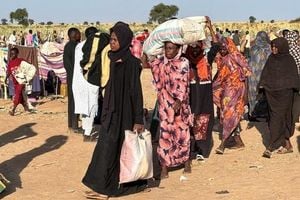South Korea woke up to a biting chill on Monday, October 20, 2025, as a sudden cold wave swept across the country, sending temperatures tumbling and catching many off guard. The week beginning October 20 marked an abrupt transition from the lingering warmth of early autumn to a distinctly wintry feel, with meteorologists and officials urging citizens to brace themselves for an unusually cold spell and to take precautions against the plummeting mercury.
According to the Korea Meteorological Administration (KMA), the cold air mass moving south from northern China brought a sharp drop in temperatures nationwide. Morning lows on October 20 ranged from 2°C to 14°C, a stark 5–10°C decrease compared to the previous day—a change felt acutely by early commuters and schoolchildren. The chill was particularly pronounced in central inland areas like Seoul, Yeoncheon, and the mountainous regions of Gangwon Province, where the season’s first frost was observed. In Seoul, the mercury dipped to 5.3°C at 6:49 a.m.—even colder than the city’s average low for early November, which typically stands at 6.3°C, as reported by Yonhap News.
But it wasn’t just the thermometer readings that had people shivering. Strong winds whipped through the streets, driving the perceived temperature even lower. In Seoul, the wind chill dropped to a brisk 3.6°C before sunrise, and in the high-altitude observation post at Seoraksan National Park, the air temperature plummeted to -1.3°C, with the wind chill plunging to a bone-chilling -8.2°C. The KMA warned that, “The wind will make it feel even colder than the actual temperature, especially in mountainous regions.”
This sudden onset of cold was not limited to the capital. Cities across the country felt the sting, with Incheon and Suwon seeing morning lows of 4°C, Chuncheon and Jeonju at 7°C, Daejeon and Sejong at 5°C, Gwangju at 8°C, Daegu at 10°C, and both Busan and Jeju at a relatively milder 15°C. The rapid change left many scrambling to pull out their winter coats and padded jackets—an early reminder that autumn’s gentle days were quickly fading.
The cold snap also brought with it a slew of weather advisories. Frost warnings were issued for the northern and eastern mountainous areas of Gangwon, with temperatures expected to drop to around -1°C by the evening and frost forming overnight. The KMA cautioned that frost and even ice would be possible in parts of Gyeonggi, Gangwon, Chungcheong, and the higher elevations of Jeolla and Jeonbuk provinces, raising concerns about potential damage to crops. “Farmers should take steps to protect their fields from frost damage,” the agency advised.
For those living in the highlands, the cold brought more than just frost. In Gangwon’s northern mountains, particularly above 1,200 meters, the rain that began in the early morning hours turned to snow, leaving behind a light accumulation of about 1 cm—the season’s first snowfall. Photos from Seoraksan National Park showed a dusting of white, signaling the true arrival of early winter. According to Hankyung.com, “As the cold air moves south, snow is expected to accumulate in some northern Gangwon highland areas during the morning.”
The chill wasn’t just a Monday phenomenon. The KMA forecast that the cold wave would persist throughout the week, with morning lows from October 21 through 26 hovering between 1°C and 15°C and daytime highs ranging from 12°C to 22°C. The coldest period was expected from October 23 to 25, when morning lows would dip to 6–15°C and highs would remain at 15–22°C. The cold wave’s peak was forecast for Sunday, October 26, with temperatures nationwide dropping to between 2°C and 15°C in the morning and only climbing to 12°C–22°C during the day.
Rain accompanied the cold in some regions. The east coast, including Gangwon Yeongdong, Gyeongbuk’s eastern coast, and the northeastern mountains, as well as the eastern part of Gyeongnam, saw intermittent showers from the early hours of October 20. The forecast called for 10–50 mm of rain in Gangwon Yeongdong and 5–30 mm in northern Gyeongbuk and its highlands, while southern regions such as Busan, Ulsan, and the eastern inland areas of Gyeongnam expected about 5 mm of precipitation. This mix of rain and cold led to slippery roads and added to the discomfort for many venturing outdoors.
Wind was another factor amplifying the chill, especially along the coasts. Gusts of up to 70 km/h (about 20 m/s) were predicted for the coastal regions of Chungnam and Jeolla, prompting strong wind advisories. The KMA also anticipated high waves and issued marine warnings for the West Sea, South Sea, and waters off Jeju, with wave heights reaching up to 5.5 meters in the East Sea, 4.0 meters in the West Sea, and 4.0 meters in the South Sea. “Coastal residents and fishermen should be on alert for strong winds and high waves,” the agency said, as reported by Asia Economy.
Despite the cold, one silver lining was the air quality. The KMA expected fine dust concentrations to remain at “good” levels throughout the week, offering some relief for those concerned about pollution. As the week progressed, the weather was set to gradually clear, especially by Sunday, October 26, when a high-pressure system would bring mostly sunny skies nationwide.
For many, the abrupt onset of cold weather was a jolt—a reminder that climate patterns can shift quickly and that preparation is key. The KMA’s advice was clear: dress warmly, take care of your health, and protect sensitive crops from frost. With the cold wave expected to linger, South Koreans are bundling up and bracing for what feels like an early start to winter, even before autumn’s colors have fully faded from the landscape.
As the week continues, all eyes will be on the skies—and the thermometer—as the nation adapts to the sudden, sharp turn in the weather.
![[날씨]전국 쌀쌀한 출근길…강원 높은 산지 첫눈 전망 - 아시아경제](https://thumbor.evrimagaci.org/PVQFXoFncd52U3VWWmTlODXc3QQ=/200x0/tpg%2Fsources%2F26f518a7-515b-4922-9517-6fb319a8b154.jpeg)



